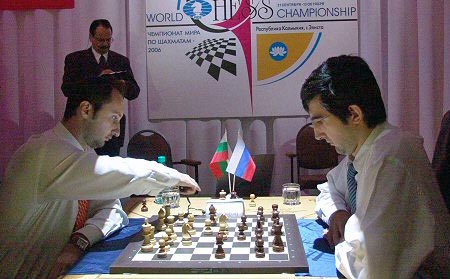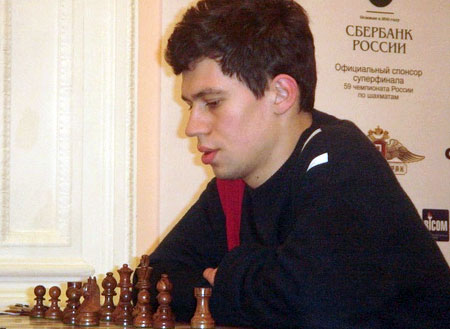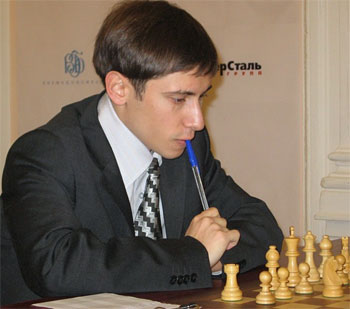| Latest | Greatest | Lobby | Journals | Search | Options | Help | Login |
|
|
|
This topic is archived. |
| Home » Discuss » Topic Forums » Sports |
|
| Jack Rabbit
|
Sun Dec-17-06 12:01 AM Original message |
| The Jack Rabbit Chess Report for December 17 |
|
Edited on Sun Dec-17-06 12:15 AM by Jack Rabbit
The Jack Rabbit Chess Report for the week ending December 17  Contents Post 1: News for the week Post 2: Diagrams and other features Post 3: Games from Current and Recent Events |
| Printer Friendly | Permalink | | Top |
| Jack Rabbit
|
Sun Dec-17-06 12:02 AM Response to Original message |
| 1. News for the week ending December 17 |
|
Edited on Sun Dec-17-06 12:56 AM by Jack Rabbit
Superfinals: Alekseev, Korbut win Russian Championships
Evgeny Alekseev is crowned Russian Champion  Evgeny Alekseev, a 21-year-old grandmaster from St. Petersburg, is the new Russian National Champion. Alekseev defeated Dmitry Jakovenko, 23, in a playoff of two rapid games hours after the completion of the eleventh round Friday in Moscow. Alekseev and Jakovenko tied for first place with 7½ points out of a possible 11. The playoff was only to determine which of the two would hold the title for the next year; they will divide first and second place prize money between them. Ernesto Inarkiev, another young Russian grandmaster who finished first in the semi-final event in September, finished third with 7 points. Peter Svidler led the old-timers by finishing fourth with 6½ points. The defending champion, Sergei Rublevsky, tied for fifth with 5½ points. Unofficial Cross Table Russian National Championship General Superfinal Moscow -------------------------- 1 2 3 4 5 6 7 8 9 0 1 2 T- (W) .1 Evgeny Alekseev. . . . .- ½ ½ ½ ½ 1 0 ½ 1 1 1 1 7½ (5) .2 Dmitry Jakovenko . . . .½ - 1 ½ 0 1 ½ 1 ½ ½ 1 1 7½ (5) .3 Ernesto Inarkiev . . . .½ 0 - ½ 1 0 ½ 1 1 ½ 1 1 7. (5) .4 Peter Svidler. . . . . .½ ½ ½ - ½ ½ ½ 1 1 ½ ½ ½ 6½ (2) .5 Ildar Khairullin . . . .½ 1 0 ½ - ½ ½ 1 0 ½ ½ ½ 5½ (2) .6 Evgeny Tomashevsky . . .0 0 1 ½ ½ - ½ ½ ½ 1 ½ ½ 5½ (2) .7 Sergei Rublevsky . . . .1 ½ ½ ½ ½ ½ - 0 ½ ½ ½ ½ 5½ (1) .8 Ian Nepomniachtchi . . .½ 0 0 0 0 ½ 1 - 1 ½ ½ 1 5. (3) .9 Denis Khismatullin . . .0 ½ 0 0 1 ½ ½ 0 - ½ 1 1 5. (3) 10 Sergey Grigoriants . . .0 ½ ½ ½ ½ 0 ½ ½ ½ - ½ 1 5. (1) 11 Nikita Vitiugov. . . . .0 0 0 ½ ½ ½ ½ ½ 0 ½ - ½ 3½ (0) 12 Evgeny Najer . . . . . .0 0 0 ½ ½ ½ ½ 0 0 0 ½ - 2½ (0) The Jack Rabbit Unofficial Cross Table uses games won as first tie break Jakovenko led the tournament most of the way. He was caught by Alekseev in the ninth round on Wednesday. Both players won Thursday and drew Friday. Jakovenko drew in all-too-typical last round style against Sergey Grigoriants, but Alekseev had to earn his right to face Jakovenko for the title by drawing the youngest player in the event, 16-year-old Ian Nepomniachtchi, in 109 moves. The event was held about six months after world champion Vladimir Kramnik, who was originally scheduled to compete as a seeded player, said that the future of Russian chess looked bleak. As if simply to prove Kramnik wrong, the general Superfinal turned into a convincing showcase of young Russian talent. Ekaterina Korbut reigns as Russian Ladies' Champion  Ekaterina Korbut won the ladies' Superfinal with 8 points out of a possible 11 in Gorodents, a medieval Russian town near Novgorod, in the tournament which finished on Tuesday. In a three-way tie for second, the Kosintseva sisters, Nadezhda and Tatiana, and 15-year-old Elena Tairova scored 7½ points each. Unofficial Cross Table Russian National Championship Ladies' Superfinal Gorodents -------------------------- 1 2 3 4 5 6 7 8 9 0 1 2 T- (W) .1 Ekaterina Korbut . . . .- 1 1 0 1 ½ ½ 0 1 1 1 1 8. (7) .2 Tatiana Kosintseva . . .0 - ½ ½ 1 ½ 1 1 1 1 0 1 7½ (6) .3 Nadezhda Kosintseva. . .0 ½ - ½ 1 1 0 1 1 ½ 1 1 7½ (6) .4 Elena Tairova. . . . . .1 ½ ½ - ½ ½ 0 1 1 1 1 ½ 7½ (5) .5 Alisa Galliamova . . . .0 0 0 ½ - 1 ½ 1 1 ½ 1 1 6½ (5) .6 Ekaterina Kovalevskaya .½ ½ 1 ½ 0 - ½ 1 ½ ½ 1 1 6½ (4) .7 Tatiana Shadrina . . . .½ 0 ½ 1 ½ ½ - 0 1 ½ ½ 1 5½ (3) .8 Elena Zayatz . . . . . .1 0 0 0 0 0 1 - 0 1 1 ½ 4½ (4) .9 Anatasia Bodnaruk. . . .0 0 0 0 0 ½ 0 1 - 0 1 1 3½ (3) 10 Svetlana Matveeva. . . .0 ½ 0 0 ½ ½ ½ 0 1 - 0 ½ 3½ (1) 11 Valentina Gunina . . . .0 1 0 0 0 0 ½ 0 0 1 - 0 2½ (2) 12 Maria Koniagina. . . . .0 0 0 ½ 0 0 0 ½ 0 ½ 1 - 2. (1) The Jack Rabbit Unofficial Cross Table uses games won as first tie break Tatiana Kosintseva led for much of the event until she was defeated by Ms. Korbut in the eighth round. Ms. Korbut had also defeated Nadezhda Kosintseva in the first round. Against each other in the second round, the Kosintseva sisters played seven moves into an Italian Game and agreed to a draw, almost exactly as they did in the fifth round of the North Urals Cup in Krasnoturinsk in July. Young Ms. Tairova, who drew both her games against the Kosintseva sisters and won her game against Ms. Korbut, was recognized as the official second place finisher based on her better Sonnigen-Berger score; however, the Kosintsevas won six games each while Ms. Tairova won five. The youngest competitor in the Superfinals, 14-year-old Anatasia Bodnaruk, finished tied for ninth with 3½ points (3 wins, 7 losses and a draw). India wins Olympic Gold in Asian Games India won the gold medal in the mixed team competition in the 15th Asian Games, an official Olympic Games event, in Doha, Qatar, last week. The Indian team of Krishnan Sasikiran, Pentala Harikrishna and Koneru Humpy were assured of the gold medal even before the final round began Wednesday. China took the silver medal and Iran, thanks to a 3-0 shut out of the strong host team, Qatar, in the last round, took the bronze. India took two out of three gold medals in chess. Earlier, Ms. Koneru won the ladies' rapid chess competition. The other gold medal, for the men's rapid competition, was won by Murtas Kazhgaleyev of Kazakhstan. The Asian Game marked the debut of chess as an Olympic sport. Topalov issues challenge to Kramnik for title rematch Bulgarian grandmaster Veselin Topalov has issued a challenge to World Champion Vladimir Kramnik for a rematch.  Topalov, who held the FIDE version of the split world title until Kramnik defeated him in October's reunification match, issued the challenged to FIDE through his manager, Silvio Danailov. The challenge is being issued under the the FIDE rule that states any player with a current rating of over 2700 who can raise US$1 million can challenge the reigning world champion to a title match; under this rule, Kramnik is obliged to accept. In his letter to FIDE, Danailov said that Topalov would prefer the match be held starting April 12 in Sofia, Bulgaria. However, that would be less than six months prior to the Mexico City world championship tournament, which is scheduled for late September and early October. Danailov said that the match could be held in March, if that was more consistent with FIDE rules. Kramnik is scheduled to participate in the annual tournament in Wijk aan Zee, Holland in January while Topalov is to compete in the Morelia/Linares event in Mexico and Spain in late February and early March. Danailov did not say whether Topalov would withdraw from the Linares/Morelia tournament in order to have time to prepare for a title match in mid-March. |
| Printer Friendly | Permalink | | Top |
| Jack Rabbit
|
Sun Dec-17-06 12:03 AM Response to Original message |
| 2. Diagrams and other features of the JR Chess Report |
|
!""""""""# $tMvWlVmT% $OoOoOoOo% $ + + + +% $+ + + + % $ + + + +% $+ + + + % $pPpPpPpP% $RnBqKbNr% /(((((((() White to move This position is a theoretical draw Does this picture make sense to you? If not, or if it looks like a bunch of Wingdings, please click here. Diagrams used in the Jack Rabbit Chess Report are made with Chess Merida, a true type font that is available as freeware at the above link. Also, the JR chess report makes the main variation in annotations more distinct and readable by putting it in red. A secondary variation, is in blue and other colors are used if needed. |
| Printer Friendly | Permalink | | Top |
| Jack Rabbit
|
Sun Dec-17-06 12:04 AM Response to Original message |
| 3. Games from current and recent events |
|
Edited on Sun Dec-17-06 12:17 AM by Jack Rabbit
Chess Games Analysis by JR and Fritz Sergey Grigoriants - Evgeny Alekseev, Russian National Championships, General Superfinal, Moscow, Round 10 Evgeny Najer - Dmitry Jakovenko, Russian National Championships, General Superfinal, Moscow, Round 8 Ekaterina Korbut - Tatiana Kosintseva, Russian National Championships, Ladies' Superfinal, Gorodets, Round 8 Elena Zayatz - Nadezhda Kosintseva, Russian National Championships, Ladies' Superfinal, Gorodets, Round 8 |
| Printer Friendly | Permalink | | Top |
| Jack Rabbit
|
Sun Dec-17-06 12:05 AM Response to Reply #3 |
| 4. Grigoriants - Alekseev, Russian Superfinals, Moscow |
 Evgeny Alekseev Sergey Grigoriants vs. Evgeny Alekseev Russian Championships, Round 10 Moscow. December 2006 East India Game: Nimzo-Indian Defense 1. d4 Nf6 2. c4 e6 3. Nc3 Bb4 4. Qc2 0-0 5. a3 Bxc3+ 6. Qxc3 d6
Black: Evgeny Alekseev !""""""""# $t+t+ +l+% $+o+ W Oo% $ Mm+v+ +% $+ + O + % $oPp+ O +% $+ Q PpN % $ + +b+pP% $R + BrK % /(((((((() White: Sergey Grigoriants Position after 23. e3xf4 23. -- Nd4!
Black: Evgeny Alekseev !""""""""# $t+t+ +l+% $+ + W Oo% $ + + + +% $+o+ P + % $o+v+q+ +% $+ Bm+pN % $ + + +pP% $R + +r+k% /(((((((() White: Sergey Grigoriants Position after 30. Ne2g3 30. -- Nc5!
|
| Printer Friendly | Permalink | | Top |
| Jack Rabbit
|
Sun Dec-17-06 12:12 AM Response to Reply #3 |
| 5. Najer - Jakovenko, Russian Superfinals, Moscow |
 Dmitry Jakovenko Evgeny Najer vs. Dmitry Jakovenko Russian National Championships, General Superfinal, Round 8 Moscow, December 2006 East India Game: Nimzo-Indian Defense 1. d4 Nf6 2. c4 e6 3. Nc3 Bb4 4. g3
Black: Dmitry Jakovenko !""""""""# $ + + +l+% $Q + +oO % $ + +v+ O% $+ + O +w% $p+ +p+ P% $+ + + P % $t+ T Pb+% $R + R K % /(((((((() White: Evgeny Najer Position after 32. Rb1a1 32. -- Qe2!!
Black: Dmitry Jakovenko !""""""""# $ + + + +% $Q + + Ol% $p+ +o+ O% $+ + O +p% $ + + + +% $+ + + Pk% $ + +rR +% $+ + + + % /(((((((() White: Evgeny Najer Position after 42. h4h5 42. -- Rf5!
|
| Printer Friendly | Permalink | | Top |
| Jack Rabbit
|
Sun Dec-17-06 12:13 AM Response to Reply #3 |
| 6. Korbut - T. Kosintseva, Russian Superfinals, Gorodents |
|
Edited on Sun Dec-17-06 12:24 AM by Jack Rabbit
 Ekaterina Korbut
Ekaterina Korbut vs. Tatiana Kosintseva Russian National Championships (Ladies' Superfinal), Round 8 Gorodets, Dedember 2006 Spanish Grand Royal Game: Neo-Classical Defense (Møller Defense) 1. e4 e5 2. Nf3 Nc6 3. Bb5 a6 4. Ba4 Nf6 5. 0-0 Bc5
Black: Tatiana Kosintseva !""""""""# $t+ + + L% $+ + +w+o% $ + OvO +% $+ V On+ % $ + +p+ +% $+ P +nPp% $ + + + K% $+r+ + + % /(((((((() White: Ekaterina Korbut Position after 37. -- Qd7f7 38. Rb7!
|
| Printer Friendly | Permalink | | Top |
| Jack Rabbit
|
Sun Dec-17-06 12:14 AM Response to Reply #3 |
| 7. Zayatz - N. Kosintseva, Russian Superfinals, Gorodents |
|
Edited on Sun Dec-17-06 12:52 AM by Jack Rabbit
 Nadezhda Kositntseva
Elena Zayatz vs. Nadezhda Kosintseva Russian National Championships (Ladies' Superfinal), Round 8 Gorodets, December 2006 King's English Game: Four Knights' Opening 1. c4 Nf6 2. Nc3 e5 3. Nf3 Nc6 4. d4 exd4
Black: Nadezhda Kosintseva !""""""""# $ + + + L% $+ + +o+ % $o+ + W O% $+o+ Np+ % $ MvPb+ +% $+ + Q + % $p+ + + P% $+ + + K % /(((((((() White: Elena Zayatz Position after 35. f4f5 35. -- Nxa2!
|
| Printer Friendly | Permalink | | Top |
| DU
AdBot (1000+ posts) |
Fri Apr 26th 2024, 04:00 AM Response to Original message |
| Advertisements [?] |
| Top |
| Home » Discuss » Topic Forums » Sports |
|
Powered by DCForum+ Version 1.1 Copyright 1997-2002 DCScripts.com
Software has been extensively modified by the DU administrators
Important Notices: By participating on this discussion board, visitors agree to abide by the rules outlined on our Rules page. Messages posted on the Democratic Underground Discussion Forums are the opinions of the individuals who post them, and do not necessarily represent the opinions of Democratic Underground, LLC.
Home | Discussion Forums | Journals | Store | Donate
About DU | Contact Us | Privacy Policy
Got a message for Democratic Underground? Click here to send us a message.
© 2001 - 2011 Democratic Underground, LLC